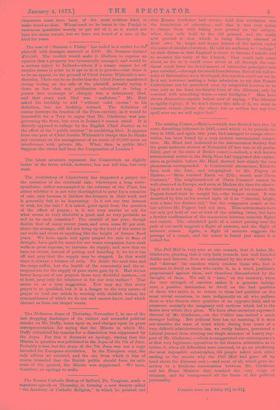The missing Comet,—Biela's,—which was divided into two by some disturbing
influence in 1846,—and which in its periodic re- turn in 1866, and again this year, had managed to escape obser- vation, has been found by a very curious astronomical conjec- ture. Mr. Hind had indicated to the Astronomical Society that the great meteoric shower of November 27 last was, in all proba- bility, part of the train of Biela's comet ;—indeed, a well-known astronomical writer in the Daily News had suggested this explan- ation as probable before Mr. Hind showed how closely the two phenomena corresponded. A Continental astronomer, Slinker- fues, took the hint, and telegraphed to Mr. Pogson at Madras,—" Biela touched Earth on 27th; search near Theta Centauri." The neighbourhood of Theta Centauri cannot be well observed in Europe, and even at Madras the time for observ- ing it well is not long. On the third evening of his research Mr. Pogson found what he sought for,—the truant comet. It was described by him on his second sight of it as "circular, bright, with a faint but distinct tail," but the companion comet at the last advices Mr. Pogson had not seen. Thus astronomers have not only got hold of one at least of the missing twins, but have a further confirmation of the connection between meteoric flights and comets. The calculated path of a comet passing near the path of our earth suggests a flight of meteors, and the flight of meteors comes. Again, a flight of meteors suggests the passage of a comet, and the comet is found just where it is looked for.










































 Previous page
Previous page